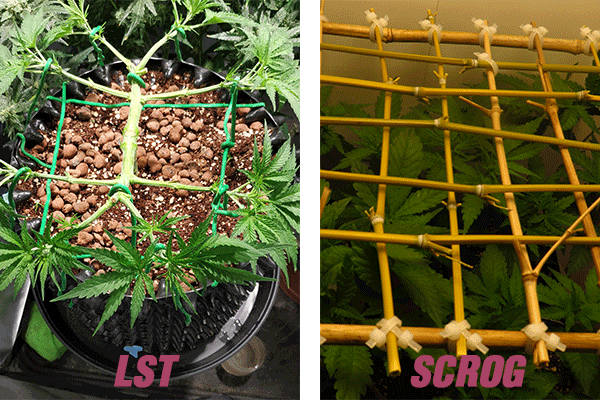How To Grow A Cannabis Bonsai
Published :
Jul 11, 2019
Categories :
Cannabis cultivation

Creating a cannabis bonsai is a meditative and peaceful process that cultivates creativity, patience, and awe. Manipulate one branch at a time, and watch your desired shape come to life.
The classic art of bonsai involves cultivating dwarf trees in containers, producing unusual yet striking results. Although the word bonsai is Japanese, meaning “planted in a container”, the origins of this art form have been traced back to the Chinese Empire. There are no strict rules in bonsai cultivation, and growers can manipulate and direct their tree in any way they see fit. The result is a nearperfect replica of a fullsized tree, with everything from the branches to the leaves being close to real proportions, but on a tiny scale. Interestingly, cannabis plants are ideal candidates for practicing bonsai.
Cannabis as a species is incredibly responsive to its environment. When conjuring an image of cannabis plants, many people think of huge, tree-like sativas that need a large outdoor space to grow. Bonsai cannabis plants are the complete opposite of this. As well as serving a stunning ornamental purpose, these plants provide a rewarding smoke at the end of the process. Crafting a cannabis bonsai is also a great option for growers seeking tiny plants they can easily keep concealed. For the more advanced, bonsais can be kept as mother plants from which you can take innumerable clones.

BONSAI CANNABIS: MORE THAN JUST A POTTED PLANT
Although the Japanese translation of bonsai might suggest otherwise, growing cannabis in a pot doesn’t immediately make it qualify as a bonsai. The art of bonsai features a lengthy list of (suggested) criteria that a specimen should display in order for it to be regarded as a true bonsai. Although some of these are extremely specific and time consuming, a few of them can be applied to a cannabis bonsai to help create the traditional look.
Criteria include replicating a tree-like form, keeping relative smallness in comparison to fully grown plants of the same strain, a wooden trunk, small leaves, a radial root base positioned behind the midline of the pot, and organised branching.
This seems like a demanding list at first glance, but even achieving two or three of these traits will bring that bonsai vibe to your plants. These can all be achieved by using the following methods, which many cannabis growers will already be familiar with.
USE SCROG AND LST TO SHAPE PLANTS
ScrOG (screen of green) and LST (low stress training) are techniques used to control the shape and size of cannabis plants whilst improving yields. Both of these methods can be used to influence branch structure and growth when cultivating a bonsai plant.
ScrOG involves suspending a mesh screen horizontally over a plant. This technique serves to create a uniform canopy and a nice, clear, tree-like trunk. ScrOG also helps to boost light exposure in the canopy, which will help in the development of your bonsai buds.
LST achieves a similar outcome in the form of condensed growth and increased uniformity. This technique involves tying down branches to the rim of the pot in order to create more branches with vertical growth, more colas, and increased light exposure. Defoliation is often conducted to free up even more space and create a compact and easytomanage plant.

HOW TO CREATE A CANNABIS BONSAI
To begin the process of growing your own cannabis bonsai, you’ll need:
- young cannabis plant
- drill
- suitable container
- gardening wire
- wooden dowel
1. You don’t need to be too picky about strain selection, but it will help to choose a variety that doesn’t grow too tall to begin with. For your plant to be bonsai-ready, it needs to have gone through the seedling phase into early-veg.
2. Use a drill to make holes along the perimeter of the rim of the pot you’re using. These serve as anchor points for the gardening wire, and will allow you to tame branches with ease.
3. To begin creating that bonsai look, you’ll need to start manipulating the stem of your young cannabis plants, eventually turning it into a woody trunk. Insert a wooden dowel into the soil near the base of the stem. Gently wrap the stem around the wooden stake into a shape of your pleasing. Grab a piece of gardening wire, loop it into one of the holes on the rim of the pot, and loop the other end over the trunk to keep it in place.
4. As your plant begins to grow, you’ll need to tame branch growth; this is where LST and ScrOG come into play. If using the ScrOG technique, allow the branches to reach the screen above, and divert branches by hand into the holes of the screen. Prune away excess growth exploding through the top to achieve a clean and uniform canopy. If using LST, use the holes and garden wire to tie down branches in whatever creative ways you choose.
5. Vegetative growth will continue after you’ve achieved the initial form you’re aiming for. You can keep your plants looking clean and shaped by pruning away new growth. Trim away new branches that emerge from established branches using clean and sharp scissors. Defoliate large and yellowing fan leaves to keep airflow and light optimal.
6. After a few weeks (or months) of trimming and shaping, your plants will be ready to flower. The aim of a bonsai plant is aesthetic beauty as opposed to yield; however, using the techniques above will still make for a decent harvest at the end of the process.
Regardless of your eventual yield, the art of bonsai is one of mindfulness and peace. As long as you enjoy the process and do your best to adhere to the tenets of the art form, your bonsai is sure to turn out a success!







































